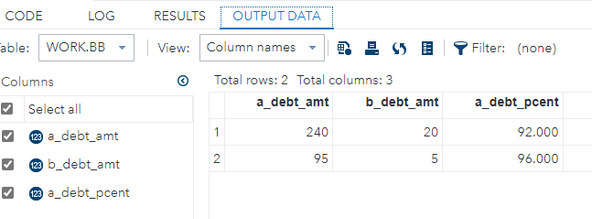- Home
- /
- Programming
- /
- Programming
- /
- Numeric division less than or greater than error
- RSS Feed
- Mark Topic as New
- Mark Topic as Read
- Float this Topic for Current User
- Bookmark
- Subscribe
- Mute
- Printer Friendly Page
- Mark as New
- Bookmark
- Subscribe
- Mute
- RSS Feed
- Permalink
- Report Inappropriate Content
Hi, I am trying to calculate the % of A debt amount within the sum of A + B debt amount, and then I want to filter out % of A debt amount is between 90 - 100% (excluding 90% and 100%). However, in my result, it return answer where a_debt_pcent = 100.. Do you know why even though I excluded 100%?
Thanks.
data aa;
input a_debt_amt b_debt_amt;
datalines;
10701.54 0
84256.96 0
21462.54 0
240 20
23876.83 0
95 5
396 184
982 3874
0 9128
;
run;
data bb;
set aa;
a_debt_pcent = 100*a_debt_amt/(a_debt_amt+b_debt_amt);
if 90 < a_debt_pcent < 100;
run;WANT:
a_debt_amt | b_debt_amt | a_debt_pcent |
| 240 | 20 | 92.307692308 |
| 95 | 5 | 95 |
What I am getting (I don't want that, it is wrong):
a_debt_amt | b_debt_amt | a_debt_pcent |
| 10701.54 | 0 | 100 |
| 84256.96 | 0 | 100 |
| 240 | 20 | 92.307692308 |
| 23876.83 | 0 | 100 |
| 95 | 5 | 95 |
Accepted Solutions
- Mark as New
- Bookmark
- Subscribe
- Mute
- RSS Feed
- Permalink
- Report Inappropriate Content
You have run into a numeric precision problem that arises from floating point calculations. This is NOT a SAS problem. It is a problem of numeric representation on digital computers.
In effect, your statement:
a_debt_pcent = 100*a_debt_amt/(a_debt_amt+b_debt_amt);is calculated like this
a_debt_pcent = (100*a_debt_amt)/(a_debt_amt+b_debt_amt);
That is, it makes the product 100*a_debt_amt for the numerator first, then sums a_debt_amt and b_debt_amt for denominator, then divides. The problem is that the numeric representation of 100*a_debtamt, will not always yield a value of 100 when divided by a_debt_amt (i.e. when b_debt_amt=0). You will see "100" because it is not printing with enough precision to show the very minor difference from 100 that might occur.
Change the statement to
a_debt_pcent = 100* (a_debt_amt/(a_debt_amt+b_debt_amt));
Then you will always get 100 when b_debt_amt is zero.
The hash OUTPUT method will overwrite a SAS data set, but not append. That can be costly. Consider voting for Add a HASH object method which would append a hash object to an existing SAS data set
Would enabling PROC SORT to simultaneously output multiple datasets be useful? Then vote for
Allow PROC SORT to output multiple datasets
--------------------------
- Mark as New
- Bookmark
- Subscribe
- Mute
- RSS Feed
- Permalink
- Report Inappropriate Content
You have run into a numeric precision problem that arises from floating point calculations. This is NOT a SAS problem. It is a problem of numeric representation on digital computers.
In effect, your statement:
a_debt_pcent = 100*a_debt_amt/(a_debt_amt+b_debt_amt);is calculated like this
a_debt_pcent = (100*a_debt_amt)/(a_debt_amt+b_debt_amt);
That is, it makes the product 100*a_debt_amt for the numerator first, then sums a_debt_amt and b_debt_amt for denominator, then divides. The problem is that the numeric representation of 100*a_debtamt, will not always yield a value of 100 when divided by a_debt_amt (i.e. when b_debt_amt=0). You will see "100" because it is not printing with enough precision to show the very minor difference from 100 that might occur.
Change the statement to
a_debt_pcent = 100* (a_debt_amt/(a_debt_amt+b_debt_amt));
Then you will always get 100 when b_debt_amt is zero.
The hash OUTPUT method will overwrite a SAS data set, but not append. That can be costly. Consider voting for Add a HASH object method which would append a hash object to an existing SAS data set
Would enabling PROC SORT to simultaneously output multiple datasets be useful? Then vote for
Allow PROC SORT to output multiple datasets
--------------------------
- Mark as New
- Bookmark
- Subscribe
- Mute
- RSS Feed
- Permalink
- Report Inappropriate Content
Round your percent calculation to the nearest whole number like this:
a_debt_pcent = round(100*a_debt_amt/(a_debt_amt+b_debt_amt), 1);
The reason has to do with numeric precision and floating point math. You can read about it here.
Try this as another example:
data _null_;
num = .1 * 3;
if num = .3 then put '1. Equal';
else put '1. Not Equal';
if round(num, .1) = .3 then put '2. Equal';
else put '2. Not Equal';
run;
- Mark as New
- Bookmark
- Subscribe
- Mute
- RSS Feed
- Permalink
- Report Inappropriate Content
Hello @newboy1218
Simple and self-explanatory changes to your code will give you the desired result.
Your a_dept_pcent is a floating point number. Hence the small changes to your expressions..
data bb;
set aa;
a_debt_pcent = round((100*a_debt_amt)/(a_debt_amt+b_debt_amt),2);
format a_debt_pcent z6.3;
if 90.000 < a_debt_pcent < 100.000;
run;The output is what you want
April 27 – 30 | Gaylord Texan | Grapevine, Texas
Registration is open
Walk in ready to learn. Walk out ready to deliver. This is the data and AI conference you can't afford to miss.
Register now and lock in 2025 pricing—just $495!
Learn how use the CAT functions in SAS to join values from multiple variables into a single value.
Find more tutorials on the SAS Users YouTube channel.
SAS Training: Just a Click Away
Ready to level-up your skills? Choose your own adventure.


